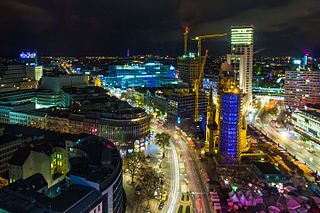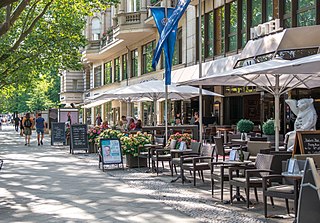
The Kurfürstendamm is one of the most famous avenues in Berlin. The street takes its name from the former Kurfürsten (prince-electors) of Brandenburg. The broad, long boulevard can be considered the Champs-Élysées of Berlin and is lined with shops, houses, hotels and restaurants. In particular, many fashion designers have their shops there, as well as several car manufacturers' show rooms.

Mitte is the first and most central borough of Berlin. The borough consists of six sub-entities: Mitte proper, Gesundbrunnen, Hansaviertel, Moabit, Tiergarten and Wedding.

Charlottenburg-Wilmersdorf is the fourth borough of Berlin, formed in an administrative reform with effect from 1 January 2001, by merging the former boroughs of Charlottenburg and Wilmersdorf.

Charlottenburg is a locality of Berlin within the borough of Charlottenburg-Wilmersdorf. Established as a town in 1705 and named after Sophia Charlotte of Hanover, Queen consort of Prussia, it is best known for Charlottenburg Palace, the largest surviving royal palace in Berlin, and the adjacent museums.

Tempelhof-Schöneberg is the seventh borough of Berlin, formed in 2001 by merging the former boroughs of Tempelhof and Schöneberg. Situated in the south of the city it shares borders with the boroughs of Mitte and Friedrichshain-Kreuzberg in the north, Charlottenburg-Wilmersdorf and Steglitz-Zehlendorf in the west as well as Neukölln in the east.

Tiergarten is a locality within the borough of Mitte, in central Berlin (Germany). Notable for the great and homonymous urban park, before German reunification, it was a part of West Berlin. Until Berlin's 2001 administrative reform, Tiergarten was also the name of a borough (Bezirk), consisting of the current locality (Ortsteil) of Tiergarten plus Hansaviertel and Moabit. A new system of road and rail tunnels runs under the park towards Berlin's main station in nearby Moabit.

U1 is a line on the Berlin U-Bahn, which is 8.8 kilometres (5.5 mi) long and has 13 stations. Its traditional line designation was BII. It runs east–west and its eastern terminus is Warschauer Straße S-Bahn station where it connects to the Schlesische Bahn. From there it runs through Kreuzberg via Gleisdreieck and Wittenbergplatz on to the Kurfürstendamm.
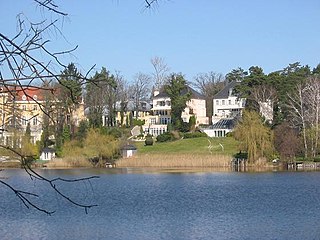
Grunewald is a locality (Ortsteil) within the Berlin borough (Bezirk) of Charlottenburg-Wilmersdorf. Famous for the homonymous forest, until 2001 administrative reform it was part of the former district of Wilmersdorf.
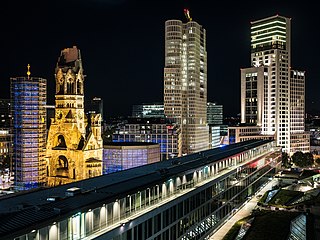
Breitscheidplatz is a major public square in the inner city of Berlin, Germany. Together with the Kurfürstendamm boulevard, it marks the centre of former West Berlin and the present-day City West. It is named after Rudolf Breitscheid.
The Greater Berlin Act, officially Law Regarding the Creation of the New Municipality of Berlin, was a law passed by the Prussian state government in 1920, which greatly expanded the size of the Prussian and German capital of Berlin.

Tauentzienstraße is a major shopping street in the City West area of Berlin, Germany. With a length of about 500 m (1,600 ft), it runs between two important squares, Wittenbergplatz in the east and Breitscheidplatz in the west, where it is continued by the Kurfürstendamm boulevard. While the eastern half belongs to the Schöneberg district, the western part is in Charlottenburg.

Wittenbergplatz is a square in the central Schöneberg district of Berlin, Germany. One of the main plazas in the "City West" area, it is known for the large Kaufhaus des Westens (KaDeWe) department store on its southwestern side.

Halensee is a locality (Ortsteil) of Berlin in the district (Bezirk) of Charlottenburg-Wilmersdorf. Halensee was established as a villa and tenement settlement in about 1880, in the suburb of Wilmersdorf, which became part of Greater Berlin in 1920. In 2004, Halensee became its own Ortsteil. With an area of 1.27 km2 it is the smallest Ortsteil in Berlin after Hansaviertel.

Charlottenburg-Nord is a locality (Ortsteil) in the northern part of the Charlottenburg-Wilmersdorf borough of Berlin, Germany. It is chiefly composed of after-war housing estates, allotment gardens and commercial zones. The locality comprises the Großsiedlung Siemensstadt, part of the Berlin Modernism Housing Estates UNESCO World Heritage Site, as well as Plötzensee Prison.

Charlottenburg Town Hall is an administrative building situated in the Charlottenburg locality of Berlin in Germany. It was built between 1899 and 1905 at the behest of the then independent city of Charlottenburg in the Prussian province of Brandenburg.

Berlin is recognized as a world city of culture and creative industries. Numerous cultural institutions, many of which enjoy international reputation are representing the diverse heritage of the city. Many young people, cultural entrepreneurs and international artists continue to settle in the city. Berlin has established itself as a popular nightlife and entertainment center in Europe.

Berlin is the capital city of Germany and one of the 16 states of Germany. With a population of 3.4 million people, Berlin is the most populous city proper, the sixth most populous urban area in the European Union, and the largest German city.
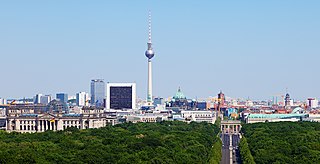
Berlin's history has left the city with an eclectic assortment of architecture. The city's appearance in the 21st century has been shaped by the key role the city played in Germany's 20th-century history. Each of the governments based in Berlin—the Kingdom of Prussia, the 1871 German Empire, the Weimar Republic, Nazi Germany, East Germany and the reunified Federal Republic of Germany—initiated ambitious construction programs, with each adding its distinct flavour to the city's architecture.

The Café des Westens, on No.18/19 Kurfürstendamm in Berlin, was a coffeehouse which operated from 1898 to 1915, and became famous as a meeting place for turn of the century artists. It was known colloquially as Café Größenwahn; the German Größenwahn meaning "delusions of grandeur".
